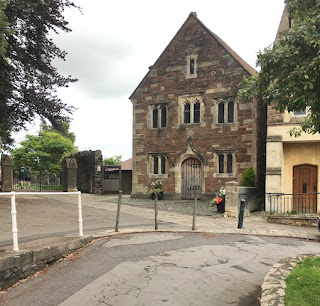Tuesday, July 23, 2019
Chew Magna, Somerset
For ales
On my way to visit the parish church of Chew Magna, I couldn't help but notice this building, right next to the churchyard gate. It was signposted as the Old Schoolroom, but I wondered, looking at it, if it was actually a medieval church house, and so it proved to be. A church house was roughly the medieval equivalent of the village or church hall. It was used for certain secular activities held on behalf of the church, especially fundraising events called church ales. As their name suggests, church ales involved a lot of drinking, together with entertainments such as dancing, plays, or sports. As many people in the Middle Ages seem to have had few inhibitions about using the church building for a range of secular activities, church ales and similar events were sometimes (perhaps often) held in the church itself. However, in some parts of the country, for example the southwestern countries of Devon and Somerset, parishes often built church houses for the purpose.
Most church houses are late medieval. This one once bore a date, 1510. This had led some people to believe that church houses became widespread when parish churches were fitted out with permanent pews in the later Middle Ages, rendering the buildings useless for activities like dancing, eating, or drinking. In any case, many clergy objected to these secular uses of church buildings, and no doubt ushered them out of the church into a more suitable building if they could. But not every church had a church house, and the cost of building one but have been considerable – the basic requirements were for a large room (often upstairs) for the festivities plus additional space for the storage and preparation of food and the brewing of beer.
The building at Chew Magna looks well built and impressive. There are plenty of windows, and a doorway with a pleasant, but not overstated, ogee head. There's a small sculpture in a niche high up, with Pevsner believes to have been St Michael killing the dragon, although this is hard to make out, plus a shield bearing the arms of the prominent local St Loe family.* The building must have been a valued social centre, although when the Puritans banned such enjoyable events as church ales, it, like others, was put to new uses – a lock-up, poorhouse, and, if the sign is to be believed, a school. Anyone wanting ale would have had to repair to one of Chew's pubs, which are still mercifully in evidence.
- - - - -
* A 15th-century St Loe has an impressive monument in the church.
Subscribe to:
Post Comments (Atom)




2 comments:
I thought I knew about most things but have not heard about church houses before. Thanks for the post.
The church house might well have been a valued social centre, attractive and useful. But you are right that the Puritans would have been horrified. I can imagine that when they saw the alcohol, the young couples, the luscious food and the festivities, the Commonwealth police would have banned any such events that gave people pleasure. A lock-up or poorhouse would have been perfect retribution.
Post a Comment